(Press-News.org) A team led by researchers at Weill Cornell Medicine and Children's National Hospital has developed a unique pre-clinical model that enables the study of long-term HIV infection, and the testing of new therapies aimed at curing the disease.
Ordinary mice cannot be infected with HIV, so previous HIV mouse models have used mice that carry human stem cells or CD4 T cells, a type of immune cell that can be infected with HIV. But these models tend to have limited utility because the human cells soon perceive the tissues of their mouse hosts as "foreign," and attack--making the mice gravely ill.
By contrast, the new mouse model, described in a paper in the Journal of Experimental Medicine on May 14, avoids this problem by using a subset of human CD4 cells that mostly excludes the cells that would attack mouse tissue. The researchers showed that the mice can usefully model the dynamics of long-term HIV infection, including the virus's response to experimental therapies.
"We expect this to be a valuable and widely used tool for studying the basic science of HIV infection, and for speeding the development of better therapies," said co-first author Dr. Chase McCann. During the study, Dr. McCann was a Weill Cornell Graduate School student in the laboratory of senior author Dr. Brad Jones, associate professor of immunology in medicine in the Division of Infectious Diseases at Weill Cornell Medicine. Dr. McCann, who was supported at Weill Cornell by a Clinical and Translational Science Center (CTSC) TL1 training award, is now the Cell Therapy Lab Lead in the Center for Cancer and Immunology Research at Children's National Hospital in Washington, DC. The other co-first authors of the study are Dr. Christiaan van Dorp of Los Alamos National Laboratory and Dr. Ali Danesh, a senior research associate in medicine at Weill Cornell Medicine.
The invention of the new mouse model is part of a wider effort to develop and test cell therapies against HIV infection. Cell therapies, such as those using the patient's own engineered T cells, are increasingly common in cancer treatment and have achieved some remarkable results. Many researchers hope that a similar strategy can work against HIV and can potentially be curative. But the lack of good mouse models has hampered the development of such therapies.
Drs. Jones and McCann and their colleagues showed in the study that the cell-attacks-host problem found in prior mouse models is chiefly due to so-called "naïve" CD4 cells. These are CD4 cells that have not yet been exposed to targets, and apparently include a population of cells that can attack various mouse proteins. When the researchers excluded naïve CD4 cells and instead used only "memory" CD4 cells, which circulate in the blood as sentinels against infection following exposure to a specific pathogen, the cells survived indefinitely in the mice without causing major damage to their hosts.
The researchers observed that the human CD4 cells also could be infected and killed by HIV, or protected by standard anti-HIV drugs, essentially in the same way that they are in humans. Thus, they showed that the mice, which they termed "participant-derived xenograft" or PDX mice, served as a workable model for long-term HIV infection. This term is akin to the "patient-derived xenograft" PDX models used to study cancer therapies, while recognizing the contributions of people with HIV as active participants in research.
Lastly, the researchers used the new model to study a prospective new T-cell based therapy, very similar to one that is now being tested against cancers. They put memory CD4 T cells from a human donor into the mice to permit HIV infection, and then, after infection was established, treated the mice with another infusion of human T cells, these being CD8-type T cells, also called "killer T cells."
The killer T cells were from the same human donor and could recognize a vulnerable structure on HIV--so that they attacked the virus wherever they found it within the mice. To boost the killer T cells' effectiveness, the researchers supercharged them with a T cell-stimulating protein called IL-15.
The treatment powerfully suppressed HIV in the mice. And although, as often seen in human cases, the virus ultimately evolved to escape recognition by the killer T cells, the ease of use of the mouse model allowed the researchers to monitor and study these long-term infection and viral escape dynamics in detail.
"I think that the major impact of this model will be its acceleration of the development of T cell-based therapies that can overcome this problem of viral escape," Dr. Jones said.
He and his laboratory are continuing to study such therapies using the new mouse model, with engineered T cells from Dr. McCann's laboratory and others.
INFORMATION:
The question of why we dream is a divisive topic within the scientific community: it's hard to prove concretely why dreams occur and the neuroscience field is saturated with hypotheses. Inspired by techniques used to train deep neural networks, Erik Hoel (@erikphoel), a research assistant professor of neuroscience at Tufts University, argues for a new theory of dreams: the overfitted brain hypothesis. The hypothesis, described May 14 in a review in the journal Patterns, suggests that the strangeness of our dreams serves to help our brains better generalize our day-to-day experiences.
"There's obviously an incredible number of theories of why we dream," says Hoel. "But I wanted to bring to ...
Rodents and pigs share with certain aquatic organisms the ability to use their intestines for respiration, finds a study publishing May 14th in the journal Med. The researchers demonstrated that the delivery of oxygen gas or oxygenated liquid through the rectum provided vital rescue to two mammalian models of respiratory failure.
"Artificial respiratory support plays a vital role in the clinical management of respiratory failure due to severe illnesses such as pneumonia or acute respiratory distress syndrome," says senior study author Takanori Takebe (@TakebeLab) of the Tokyo Medical and Dental University and the Cincinnati Children's Hospital Medical Center. "Although the side effects and safety need to be thoroughly ...
Climate change is known to negatively affect agriculture and livestock, but there has been little scientific knowledge on which regions of the planet would be touched or what the biggest risks may be. New research led by Aalto University assesses just how global food production will be affected if greenhouse gas emissions are left uncut. The study is published in the prestigious journal One Earth on Friday 14 May.
'Our research shows that rapid, out-of-control growth of greenhouse gas emissions may, by the end of the century, lead to more than a third of current global food production falling into conditions in which no food is produced today - that is, out of safe climatic space,' explains Matti Kummu, professor of global water and food issues at Aalto University.
According ...
What The Study Did: Researchers analyzed changes in filled prescriptions for naloxone (medication to reverse opioid overdoses) during the COVID-19 pandemic in the United States and compared them with changes in opioid prescriptions and overall prescriptions.
Authors: Ashley L. O'Donoghue, Ph.D., of the Beth Israel Deaconess Medical Center in Boston, is the corresponding author.
To access the embargoed study: Visit our For The Media website at this link https://media.jamanetwork.com/
(doi:10.1001/jamahealthforum.2021.0393)
Editor's Note: The ...
What The Study Did: Associations of staffing and testing interventions with COVID-19 transmission in nursing homes are examined in this decision analytical modeling study.
Authors: Rebecca Kahn, Ph.D., of the Harvard T.H. Chan School of Public Health in Boston, is the corresponding author.
To access the embargoed study: Visit our For The Media website at this link https://media.jamanetwork.com/
(doi:10.1001/jamanetworkopen.2021.10071)
Editor's Note: The article includes conflict of interest and funding/support disclosures. Please see the article for additional information, including other authors, author contributions and affiliations, conflict of interest and financial disclosures, ...
What The Study Did: This is a qualitative study that evaluates a crowdsourcing open call to gather community input for engaging the university community in COVID-19 safety strategies.
Authors: Suzanne Day, Ph.D., of the University of North Carolina at Chapel Hill, is the corresponding author.
To access the embargoed study: Visit our For The Media website at this link https://media.jamanetwork.com/
(doi:10.1001/jamanetworkopen.2021.10090)
Editor's Note: This article includes funding/support disclosures. Please see the article for additional information, including other authors, author contributions and affiliations, conflict of interest and financial disclosures, and funding and support.
INFORMATION:
Media ...
What The Study Did: Researchers evaluated the compliance of hospitals with a Centers for Medicare & Medicaid Services ruling mandating that a list of charges for services, procedures and items be publicly available and in a machine-readable file.
Authors: David Hsiehchen, M.D., of the University of Texas Southwestern Medical Center in Dallas, is the corresponding author.
To access the embargoed study: Visit our For The Media website at this link https://media.jamanetwork.com/
(doi:10.1001/jamanetworkopen.2021.10109)
Editor's Note: Please see the article for additional information, ...
Tokyo, Japan - Oxygen is crucial to many forms of life. Its delivery to the organs and tissues of the body through the process of respiration is vital for most biological processes. Now, researchers at Tokyo Medical and Dental University (TMDU) have shown that oxygen can be delivered through the wall of the intestine to compensate for the reduced availability of oxygen within the body that occurs in lung diseases that cause respiratory failure.
To breathe is to live; for higher animals, respiration involves absorbing oxygen and excreting carbon dioxide at gills or in the lungs. However, some animals have evolved alternative ventilatory mechanisms: loaches, catfish, sea cucumbers and orb-weaving spiders can absorb oxygen through their hindgut to ...
Scientists have uncovered the exact mechanism that causes new solar cells to break down, and suggest a potential solution.
Solar cells harness energy from the Sun and provide an alternative to non-renewable energy sources like fossil fuels. However, they face challenges from costly manufacturing processes and poor efficiency - the amount of sunlight converted to useable energy.
Perovskites are materials developed for next-generation solar cells. Although perovskites are more flexible cheaper to make than traditional silicon-based solar panels and deliver similar efficiency, perovskites ...
University of Alberta scientists have identified a receptor in cells that could be key to preventing permanent hearing loss in childhood cancer survivors who are being treated with the drug cisplatin. The researchers believe by inhibiting the receptor, they may be able to eliminate toxic side-effects from the drug that cause the hearing loss.
Cisplatin is an incredibly effective chemotherapeutic when it comes to treating solid tumours in children, contributing to an 80 per cent overall survival rate over five years, according to U of A researcher Amit Bhavsar, an assistant professor in the Department of Medical Microbiology & Immunology. The problem ...




